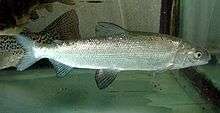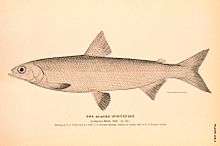Coregonus
Coregonus is a diverse genus of fish in the salmon family (Salmonidae). The Coregonus species are known as whitefishes. The genus contains at least 68 described extant taxa, but the true number of species is a matter of debate. The type species of the genus is Coregonus lavaretus.
| Coregonus | |
|---|---|
 | |
| Lake whitefish, Coregonus clupeaformis | |
| Scientific classification | |
| Kingdom: | Animalia |
| Phylum: | Chordata |
| Class: | Actinopterygii |
| Order: | Salmoniformes |
| Family: | Salmonidae |
| Subfamily: | Coregoninae |
| Genus: | Coregonus Linnaeus, 1758 |
| Type species | |
| Coregonus lavaretus | |
| Species | |
|
Nearly 70 extant members | |
Most Coregonus species inhabit lakes and rivers, and several species, including the Arctic cisco (C. autumnalis), the Bering cisco (C. laurettae), and the least cisco (C. sardinella) are anadromous, moving between salt water and fresh water.
The genus was previously subdivided into two subgenera Coregonus ("true whitefishes") and Leucichthys ("ciscoes"), Coregonus comprising taxa with sub-terminal mouth and usually a benthic feeding habit, Leucichthys those with terminal or supra-terminal mouth and usually a pelagic plankton-feeding habit. This classification is not natural however: based on molecular data, ciscoes comprise two distinct lineages within the genus. Moreover, the genus Stenodus is not phylogenetically distinct from Coregonus.[1]
Many whitefish species or ecotypes, especially from the Great Lakes and the Alpine lakes of Europe, have gone extinct over the past century or are endangered. Among 12 freshwater fish considered extinct in Europe, 6 are Coregonus.[2] All Coregonus species are protected under appendix III of the Bern Convention.
Species diversity
There is much uncertainty and confusion in the classification of the many of species of this genus. Particularly, one extreme view of diversity recognises just two main species in Northern and Central Europe, the common whitefish C. lavaretus and the vendace C. albula, whereas others would divide these into numerous, often narrowly distributed species. A drastic increase in number of recognized species occurred in 2007, when a review advocated that more than 50 local European populations should be considered as distinct based on morphological differences.[3] It has been estimated that several of them are very young, having separated from each other less than 15,000 years ago.[4] Many of these were primarily defined based on number of gill rakers. Although this largely is hereditary, the number is highly variable (even within single populations and species), can change relatively fast in response to changes and genetic studies have shown that they often are of limited use in predicting relationships among populations (a large difference in gill raker number does not necessarily equal a distant relationship).[5][6][7] Genetic differences between several of the recently proposed species, even ones that are relatively distinct morphologically, are very limited and sometimes they are not monophyletic.[5][6] Various Coregonus, whether regarded as separate species or not, readily interbreed with each other.[8] A review of whitefish in the United Kingdom found that the identification key provided in 2007 did not match most individuals and that solid evidence for more than one species in that region is lacking.[9] Many European lakes have more than one Coregonus morph differing in ecology and morphology (especially gill rakers).[10] Such morphs are sometimes partially reproductively isolated from each other, leading to suggestions of recognizing them as separate but clinal species.[4] The morphs or clinal species may rapidly (in 15 years or less, equalling three Coregonus generations) disappear by merging into a single in response to changes in the habitat.[10] A similar pattern can be seen in North America where the ciscoes of the Coregonus artedi complex in the Great Lakes and elsewhere comprise several, often co-occurring morphs or ecotypes, whose taxonomic status remains controversial.[11][12][13][14]
In 2017, FishBase listed 78 species, including the more than 50 proposed for Europe in 2007.[15] Some of these are recently extinct (marked with a cross, "†") and C. reighardi is likely extinct.[3][13]
- Coregonus albellus Fatio, 1890 (autumn brienzlig)
- Coregonus albula Linnaeus, 1758 (vendace)
- †Coregonus alpenae (Koelz, 1924) (longjaw cisco)
- Coregonus alpinus Fatio, 1885 (kropfer)
- Coregonus anaulorum Chereshnev, 1996
- Coregonus arenicolus Kottelat, 1997
- Coregonus artedi Lesueur, 1818 (northern cisco or lake herring)

- Coregonus atterensis Kottelat, 1997
- Coregonus austriacus C. C. Vogt, 1909
- Coregonus autumnalis (Pallas, 1776) (Arctic cisco)
- Coregonus baerii Kessler, 1864
- Coregonus baicalensis Dybowski, 1874
- Coregonus baunti Mukhomediyarov, 1948
- Coregonus bavaricus Hofer, 1909
- Coregonus bezola Fatio, 1888 (bezoule)
- Coregonus candidus Goll, 1883
- Coregonus chadary Dybowski, 1869 (Khadary whitefish)
- Coregonus clupeaformis (Mitchill, 1818) (lake whitefish)
- Coregonus clupeoides Lacépède, 1803 (powan)
- Coregonus confusus Fatio, 1885
- Coregonus danneri C. C. Vogt, 1908
- Coregonus duplex Fatio, 1890
- Coregonus fatioi Kottelat, 1997
- †Coregonus fera Jurine, 1825 (fera)
- Coregonus fontanae M. Schulz & Freyhof, 2003 (Stechlin cisco)
- †Coregonus gutturosus (C. C. Gmelin (de), 1818)
- Coregonus heglingus Schinz, 1822
- †Coregonus hiemalis Jurine, 1825 (gravenche)
- Coregonus hoferi L. S. Berg, 1932
- Coregonus holsata Thienemann, 1916

- Coregonus hoyi (Milner, 1874) (bloater)
- Coregonus huntsmani W. B. Scott, 1987 (Atlantic whitefish)
- †Coregonus johannae (G. Wagner, 1910) (deepwater cisco)
- Coregonus kiletz Michailovsky, 1903
- Coregonus kiyi (Koelz, 1921) (kiyi)
- Coregonus ladogae Pravdin, Golubev & Belyaeva, 1938
- Coregonus laurettae T. H. Bean, 1881 (Bering cisco)

- Coregonus lavaretus Linnaeus, 1758 (common whitefish, European whitefish; lavaret)
- Coregonus lucinensis Thienemann, 1933
- Coregonus lutokka Kottelat, Bogutskaya & Freyhof, 2005
- Coregonus macrophthalmus Nüsslin, 1882
- Coregonus maraena (Bloch, 1779) (maraena whitefish)
- Coregonus maraenoides L. S. Berg, 1916
- Coregonus maxillaris Günther, 1866
- Coregonus megalops Widegren, 1863 (lacustrine fluvial whitefish)
- Coregonus migratorius (Georgi, 1775) (omul)
- Coregonus muksun (Pallas, 1814) (muksun)
- Coregonus nasus (Pallas, 1776) (broad whitefish)

- Coregonus nelsonii T. H. Bean, 1884 (Alaska whitefish)
- Coregonus nigripinnis (Milner, 1874) (blackfin cisco)
- Coregonus nilssoni Valenciennes, 1848
- Coregonus nipigon (Koelz, 1925)
- Coregonus nobilis Haack, 1882
- †Coregonus oxyrinchus Linnaeus, 1758 (houting)
- Coregonus palaea G. Cuvier, 1829
- Coregonus pallasii Valenciennes, 1848
- Coregonus peled (J. F. Gmelin, 1789) (peled)
- Coregonus pennantii Valenciennes, 1848 (gwyniad)

- Coregonus pidschian (J. F. Gmelin, 1789) (humpback whitefish)
- Coregonus pollan W. Thompson, 1835 (Irish pollan)
- Coregonus pravdinellus Dulkeit, 1949
- Coregonus reighardi (Koelz, 1924) (shortnose cisco)
- Coregonus renke (Schrank, 1783)
- Coregonus restrictus Fatio, 1885
- Coregonus sardinella Valenciennes, 1848 (Sardine cisco)
- Coregonus stigmaticus Regan, 1908 (schelly)
- Coregonus subautumnalis Kaganowsky, 1932
- Coregonus suidteri Fatio, 1885
- Coregonus trybomi Svärdson (sv), 1979
- Coregonus tugun (Pallas, 1814)
- Coregonus ussuriensis L. S. Berg, 1906 (Amur whitefish)
- Coregonus vandesius J. Richardson, 1836 (vendace)
- Coregonus vessicus Dryagin, 1932
- Coregonus wartmanni (Bloch, 1784)
- Coregonus widegreni Malmgren, 1863 (Valaam whitefish)
- Coregonus zenithicus (D. S. Jordan & Evermann, 1909) (shortjaw cisco)
- Coregonus zuerichensis Nüsslin, 1882
- Coregonus zugensis Nüsslin, 1882
References
- Bernatchez L, Colombani F, Dodson JJ (1991) Phylogenetic relationships among the subfamily Coregoninae as revealed by mitochondrial DNA restriction analysis Journal of Fish Biology 39 (Suppl A):283-290.
- Closs, G.P.; M. Krkosek; J.D. Olden, eds. (2016). Conservation of Freshwater Fishes, p. 8. Cambridge University Press. ISBN 978-1-107-04011-3
- Kottelat, M.; and J. Freyhof (2007). Handbook of European Freshwater Fishes. ISBN 9782839902984
- Hudson, A.G.; B. Lundsgaars-Hansen; K. Lucek; P. Vonlanthen; and O. Seehausen (2016). Managing cryptic biodiversity: Fine‐scale intralacustrine speciation along a benthic gradient in Alpine whitefish (Coregonus spp.). Evolutionary Applications 10(3). doi:10.1111/eva.12446
- Østbye K.; Bernatchez L.; Naesje T.F.; Himberg K.J.; and Hindar K. (2005). Evolutionary history of the European whitefish Coregonus lavaretus (L.) species complex as inferred from mtDNA phylogeography and gill-raker numbers. Mol Ecol. 14(14):4371-4387. doi:10.1111/j.1365-294X.2005.02737.x
- Jacobsen M.W.; Hansen M.M.; Orlando L.; Bekkevold D.; Bernatchez L.; Willerslev E.; and Gilbert M.T. (2012). Mitogenome sequencing reveals shallow evolutionary histories and recent divergence time between morphologically and ecologically distinct European whitefish (Coregonus spp.). Mol Ecol. 21(11): 2727-2742. doi:10.1111/j.1365-294X.2012.05561.x
- Ozerov, M.Y.; M. Himberg; T. Aykanat; D.S. Sendek; H. Hägerstrand; A. Verliin; T. Krause; J. Olsson; C.R. Primmer; and A. Vasemägi (2015). Generation of a neutral FST baseline for testing local adaptation on gill-raker number within and between European whitefish ecotypes in the Baltic Sea basin. Journal of Evolutionary Biology 28(5): 1170–1183. doi:10.1111/jeb.12645
- U.S. Fish and Wildlife (2011, revised 2017). Maraena Whitefish (Coregonus maraena). Retrieved 12 April 2018.
- Etheridge, E.C.; C. E. Adams; C. W. Bean; N. C. Durie; A. R. D. Gowans; C. Harrod; A. A. Lyle; P. S. Maitland; and I. J. Winfield (2012). Are phenotypic traits useful for differentiating among a priori Coregonus taxa? Journal of Fish Biology 80: 387–407. doi:10.1111/j.1095-8649.2011.03189.x
- Bhat, S.; P.-A. Amundsen; R. Knudsen; K.Ø. Gjelland; S.-E. Fevolden; L. Bernatchez; and K. Præbel (2014). Speciation Reversal in European Whitefish (Coregonus lavaretus (L.)) Caused by Competitor Invasion. PLoS ONE 9(3): e91208. doi:10.1371/journal.pone.0091208
- Turgeon, J.; A. Estoup; and L. Bernatchez (1999). Species Flock in the North American Great Lakes: Molecular Ecology of Lake Nipigon Ciscoes (Teleostei: Coregonidae: Coregonus). Evolution 53(6): 1857-1871. doi:10.1111/j.1558-5646.1999.tb04568.x
- Turgeon, J.; and L. Bernatchez (2003). Reticulate evolution and phenotypic diversity in North American ciscoes, Coregonus ssp. (Teleostei: Salmonidae): implications for the conservation of an evolutionary legacy. Conservation Genetics 4(1): 67–81.
- Eshenroder, R.L.; P. Vecsei; O.T. Gorman; D. Yule; T.C. Pratt; N.E. Mandrak; D.B. Bunnell; and A.M. Muir (2016). Ciscoes (Coregonus, subgenus Leucichthys) of the Laurentian Great Lakes and Lake Nipigon. United States Geological Survey. Retrieved 12 April 2018.
- Boguski, D.A.; L. Murray; T.C. Pratt; J.D. Johnson; and J.D. Reist (2016). Patterns of morphological diversity in ciscoes distributed within three of Manitoba’s glacial relict lakes, with reference to Shortjaw Cisco (Coregonus zenithicus). DFO Can. Sci. Advis. Sec. Res. Doc. 2013/107. iv+20 p.
- Froese, Rainer and Pauly, Daniel, eds. (2017). Species of Coregonus in FishBase. December 2017 version.
- "Coregonus". Integrated Taxonomic Information System. Retrieved 12 December 2004.
- Division of Endangered Species, U.S. Fish and Wildlife Service. "Extinct Species List". U.S. Fish and Wildlife Service. Retrieved 12 December 2004.